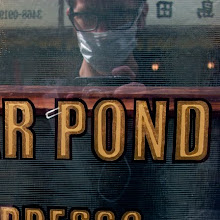It's inevitable with art fairs, even those as focused as VOLTA NY with its 80+ galleries spread across one big floor, for me to miss key emotive elements the first go-round. Or for me to approach an artist's work I've been totally stoked about, see it, then check it out again a few days later and see way more than I'd initially noticed. As I hone in on my own thoughts of the fair, I revisit here some of those instances, where it took multiple takes for the art to work itself deep into my consciousness, where once it was there it wouldn't totally chill out until I produced some thoughts in this blog.
I'd been awaiting Dirk Vander Eecken's large lacquered canvases (at Antwerp's Galerie Van Der Mieden, Booth B8) since I'd first seen his page on VOLTA NY's site. I mean, heavily patterned, ostensibly monochromatic abstracts that look like screenprints (or better yet: photocopies) totally gets me going. Makes me think of my happiest moments around Christopher Wool (his non-text paintings) and Wade Guyton (his most cerebral inkjet works). Well guess what: Eecken was doing that first, optic constructs blending science (he cooperates w/ the Department of Physics at the University of Antwerp in experimental works) with a surprising density of tonal effects. His most sublime works glow with flashes of underlying color, like the pixel damage resulting from over-zooming a lo-res image. Borders (i.e. bare canvas) figure into Eecken's oeuvre, too, but they're purposefully slightly ajar, echoing printing errors — yet his works aren't "printed" per se, either.
Another example: the Canadian artist Dil Hildebrand (showing w/ Pierre-François Ouellette, Booth G14) and his beguiling sort-of photorealistic sort-of Gerhard Richter-esque effected (either softly blurred or brutally colorful, at once) paintings. They depict fairly banal modern designer-y interiors, but how they manage this duality between trompe l'oeil and jeweled impasto slashes is beyond me. I can say w/ certainty, though, that they lock the gaze, either from up close or from across the fair floor, which I tried whenever I had a clear line-of-sight. Features like staircases and contours of furniture appear and recede from panes of color and lines, so naturally that the effect sneaks up on you.
I had to spend some time w/ Dan Tague's remarkable large-scale archival inkjet prints of U.S. bills, painstakingly crumpled and folded to form words w/in the money, then photographed on black grounds. His booth at Jonathan Ferrara Gallery (V7) is lined in double-rows with these prints. For one, the currency is familiar to Americans (obvs) and probably to many other viewers, but we've not seen it this huge, every colored security thread sinisterly revealing itself. The words Tague manages to locate and reveal in these works (everything's folded, not cut-and-pasted) may say something about the loaded nature of U.S. currency — or at least it emphasizes the fertile lexical palette he had to work from. Work titles echo the messages in the bills: Live Free or Die, State of Fear (those security threads are particularly notable here), Reality Sucks, the badass accomplishment of We Need a Revolution. Susanne Simonson's subtly eerie paintings are deceptively "easy to get" (at London's Fred Gallery, Booth D4) — but they're built from countless hours of dry brushstrokes, slowly revealing their source material (clay sculpture as portraiture, cardboard confabs as landscapes) in their hazy depths. That Simonson manages such sublime results from laborious, complicated sets is one level of awesome. That she also reigns in the chill of her native Sweden, rendering cold air in the wake of these paintings, is extra-awesome.
I quite liked the timelessness of Christian Schoeler's enveloping paintings (with Dusseldorf's Schuebbe Projects, Booth D8). The models are all fairly androgynous males, mostly in nondescript, lovely nature — think sun-blanched fields, shadowed forests, flowery meadows. They also rarely reveal their gaze, acting as semi self-portraits and also relatable to us the viewers. That timelessness places them somewhere back in art history, too. Before experiencing Schoeler's work in person, I was thinking he'd be a bit like Elizabeth Peyton (purely for the figurative and androgynous elements), but no way. That timelessness transports him somewhere further back, like to Pierre Bonnard or earlier, pre-Fin de Siecle Paris, in his fresh figure-inhabited scenes.
skip to main |
skip to sidebar
Twitter
Blog Archive
-
▼
2011
(58)
-
▼
March
(9)
- fee's LIST (through 4/5)
- my TOP TEN shocking films
- fee's LIST (through 3/29)
- fee's LIST (through 3/22)
- Strange Films I've Seen: THIRTEEN ASSASSINS
- Living at VOLTA NY (Looking again)
- Living at VOLTA NY (Friday, environments and exper...
- Living at VOLTA NY (Thursday, playing with scale a...
- fee's LIST (through 3/8)
-
▼
March
(9)





